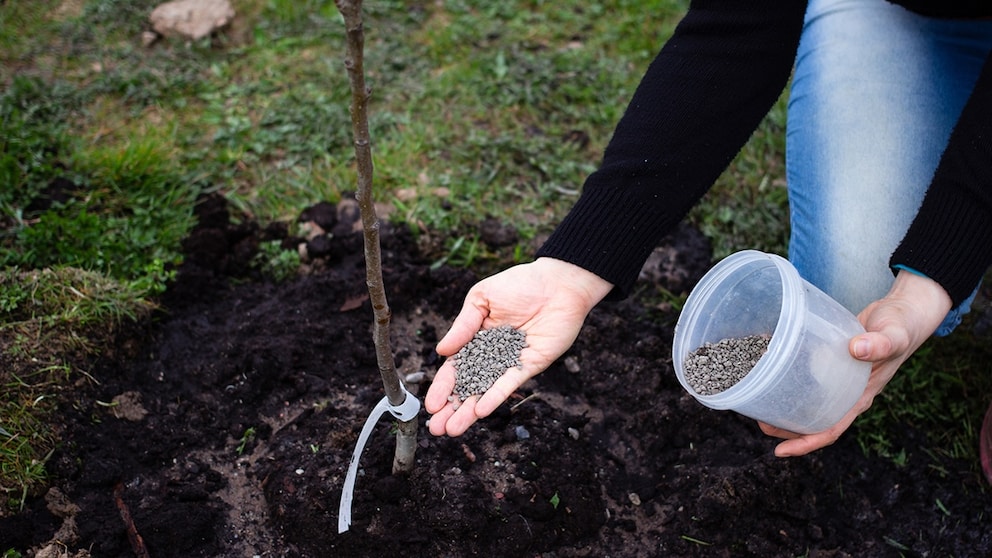April 10, 2025, 2:40 pm | Read time: 4 minutes
Fruit trees need sufficient nutrients to stay healthy and bear plenty of fruit. Here, you can find out when fertilization makes sense, which products are suitable, and how to apply them correctly.
Whether apple, pear, or cherry — fruit trees are among the most valuable plants in the garden. With a little care and patience, they bear delicious fruit for years. But every harvest costs the tree energy. With every fruit harvested, every branch cut off, and every leaf that falls, the tree loses nutrients that it has previously taken from the soil. Without a supply of nutrients, not only the harvest suffers, but also the health of the tree. Diseases and pests have an easier time, growth slows down, and the quality of the fruit decreases. If you want to keep your fruit trees healthy and productive in the long term, you should, therefore, regularly fertilize and return nutrients — adapted to age, location, and season.
When Should You Fertilize Fruit Trees?
In the first year after planting, restraint is advised with regard to fertilization. Normal garden soil should not be fertilized at all in the beginning. This encourages root formation, as the young tree should actively search for water and nutrients. Only on poor soils should compost be mixed in to help the tree get off to a good start.
From the second year onwards, the tree needs more support. The main fertilization takes place in early spring, ideally in March or April. This is when the tree starts to sprout and needs energy for new growth.
A second fertilization can take place in June after the summer solstice. Now, the tree switches from vegetative to generative growth. In this phase, it concentrates on fruit ripening and, at the same time, already produces flowers for the coming year. Potassium and phosphorus-rich fertilizers are particularly important now, while nitrogen should be applied sparingly.
What Should You Use to Fertilize Fruit Trees?
Organic fertilizers are always the first choice for natural gardening. Compost, but also well-rotted manure, horn meal, sheep’s wool, or vegetable slurry not only improve the nutrient supply but also the soil life and structure.
In the first few years, an application of around one to one and a half liters of compost and around ten grams of horn meal per tree is sufficient. With increasing age and size, the requirement increases: mature trees can make good use of four liters of compost and up to 140 grams of horn meal per year, ideally applied in late March.
If you want to avoid animal products, you can use so-called “vegan horn shavings.” They release nutrients slowly and can be combined well with compost.
Mineral fertilizers are also an option. Natural variants such as rock flour are well suited to supplementing nutrients in a targeted manner. Synthetic fertilizers can also be used and work quickly, but are usually unnecessary in the home garden. Balanced, organic-based fertilization is generally the more sustainable and safer choice.

Growing Cucumbers on the Balcony – How to Harvest Successfully

Planting and Care Tips for the Primeval Tree Fern

Planting and caring for blackcurrants in the garden
How Should Fruit Trees Be Fertilized?
Fertilizing in an Open, Unvegetated Area
The so-called tree disc — i.e., the area around the trunk — should be kept free of vegetation. A diameter of about one meter is sufficient. Here, the fertilizer is evenly distributed and lightly worked into the soil. It is crucial that fertilizer is not only applied directly to the trunk. The fine root tips, which absorb nutrients particularly effectively, are located at the edge of the crown, i.e., the outer edge of the tree crown.
Fertilizing on Lawns or Overgrown Areas
If the tree is standing in a meadow or on a lawn, the application of nutrients is somewhat more challenging. In such cases, deep slits can be made in the soil with a spade at regular intervals in the outer crown area. The fertilizer is poured into these slits so that it reaches the roots directly — without being intercepted by the surrounding vegetation.

